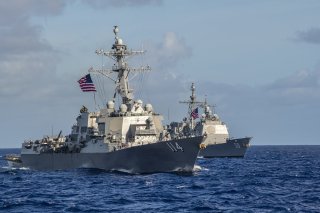Breaking Down the U.S. Navy's Large Surface Combatants
Here is what you need to know about some of the Navy’s different types of destroyers, and what sets them apart from other ships.
The U.S. Navy’s ship classifications are not always straightforward. Thankfully, the Congressional Research Service offers some clarification on the differences between types of warships.
“Decades ago, the Navy’s cruisers were considerably larger and more capable than its destroyers. In the years after World War II, however, the Navy’s cruiser designs in general became smaller while its destroyer designs in general became larger,” the report explains.
“As a result, since the 1980s, there has been substantial overlap in size and capability of Navy cruisers and destroyers. (The Navy’s new Zumwalt [DDG-1000] class destroyers, in fact, are considerably larger than the Navy’s cruisers.)
For this reason, “the Navy now refers to its cruisers and destroyers collectively as large surface combatants (LSCs), and distinguishes these ships from the Navy’s small surface combatants (SSCs), the term the Navy now uses to refer collectively to its frigates, Littoral Combat Ships (LCSs), mine warfare ships, and patrol craft.”
Arleigh Burke-class
The Navy’s workhorse is the Arleigh Burke-class destroyers. Initially designed in the late 1970s, these ships have steadily incorporated incremental updates and improvements, resulting in several different variants, also called “flights.”
The class has been incredibly successful. It is one of the “longest-running shipbuilding programs in Navy history,” and also one of the Navy’s “numerically largest classes of ships since World War II.”
They are multi-mission platforms that emphasize anti-air warfare and deep, blue-water, or open ocean operations. As part of the class’ anti-air warfare, they are equipped with the Aegis combat system, “an integrated ship combat system named for the mythological shield that defended Zeus.”
In addition, some Arleigh Burke-class destroyers can conduct ballistic missile defense and protect islands or coastlines from enemy missiles.
Zumwalt-Class Destroyers
The Navy explains that the Zumwalt-class are also “multi-mission destroyers with an originally intended emphasis on naval surface fire support and operations in littoral (i.e., near-shore) waters.”
As part of that mission, the class was designed with a pair of 155mm naval guns called the Navy called Advanced Gun Systems. These guns were built to fire an advanced 155mm projectile in support of forces onshore.
The Advanced Gun System was great on paper. But, unfortunately, the projectiles were prohibitively expensive — around $800,000 or more per shot. The Zumwalt program faced ballooning costs and was eventually limited to three ships.
However, the three ships were also outfitted with specially-designed Vertical Launch Cells along the ship’s edges, affording the ship an anti-surface ship and land strike capability to salvage the program.
Caleb Larson is a multimedia journalist and defense writer with the National Interest. A graduate of UCLA, he also holds a Master of Public Policy and lives in Berlin. He covers the intersection of conflict, security, and technology, focusing on American foreign policy, European security, and German society for both print and radio. Follow him on Twitter @calebmlarson
Image: U.S. Navy Flickr.

